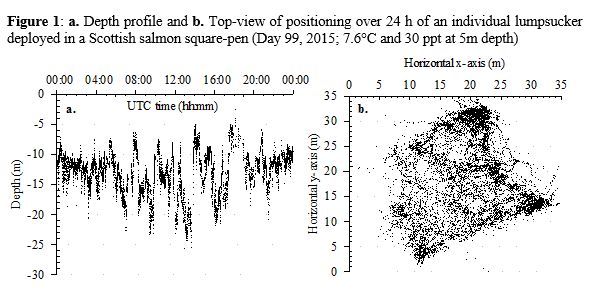DEVELOPMENT OF BEST PRACTICES FOR THE MAINTENANCE OF CLEANER FISH IN COMMERCIAL SCOTTISH SALMON (SALMO SALAR) NET-PENS: SUPPLEMENTARY FEEDING AND 3D BEHAVIOURAL STUDY
Introduction
The use of cleaner-fish against sea lice recently emerged as a central component of Integrated Pest Management (IPM) in the European Atlantic salmon industry. Cleaner-fish are typically deployed preventively within commercial salmon net-pens. In ballan wrasse, a loss of body condition was evident within 6 weeks of deployment despite a high initial lice density and documented delousing activity (Skiftesvik et al., 2013). Low survival is accordingly reported in commercial sites and this is suspected to originate or to be aggravated by low feed availability. Supplementary feeding of ballan wrasse was found not to negatively affect lice consumption (Leclercq et al., 2014) and is increasingly desired to sustain the welfare and efficacy of the biological stock over the salmon grow-out cycle. However, no manufactured feed product with satisfactory water-stability is currently commercially available for wrasse. Further, empirical observation of the biological controls under varying commercial conditions is difficult restricting the direct improvement of husbandry practices.
This paper will present advances in the supplementary feeding of ballan wrasse and knowledge gained from a fine-scale 3D behavioural study of cleaner-fish deployed in commercial Scottish salmon net-pens.
Methods
Feed development and cross survey
A range of experimental feed were prepared mixing a complete manufactured wrasse diet (Symbio Maintenance, BioMarltd) as base component with alterations in hydrocolloid agent type (Gelatins and agar-agar), concentration and proportion. Experimental feed were tested for water-stability, nutrients leaching, palatability and preference. The selected formulation was further tested for bacterial, yeast and mould counts over time under different storage conditions to estimate shelf-life.
Using the developed feed, a feeding strategy was established that defined quantities, frequencies and feeders depth according to temperature and lice level in addition to feed intake monitoring. This was implemented in 2 commercial salmon sea-sites over 2014-15. A third sea-site feeding low levels of wrasse extruded pellets was surveyed for lice level, nutritional condition, health and survival of the wrasse for comparison.
Comparative and seasonal behaviour survey
The study was performed within two adjacent commercial salmon net-pens (25 m * 25 m square pens, 16 to 20 m depth; Marine Harvest (Scotland)Ltd, loch Leven) stocked with Q1 2014 Atlantic salmon (n = 74660 ± 424) and either wild temperate wrasse or lumpsuckers (Cyclopterus lumpus) at 5% and 4% respectively stocking ratio.
An acoustic fine-scale positioning system (HTI hydroacoustic technology Inc) comprising 8 hydrophones (Model 590) surrounding the rearing pens was deployed and connected to an acoustic tag receiver (Model 290) with wi-fi connectivity to a shore-based desktop for data processing. Acoustic tags (Model 795-LD; 307 kHz) were surgically implanted intraperitoneally and cleaner-fish left to recover for 48 h in a sea-submerged perforated container prior to release in salmon pens. Each tag was set to emit at specific time intervals (6 to 12 sec with a non-encoded 2msec double-pulse) allowing individual positioning at each interval for an estimated tag life-span of ~3 months. Two trials were performed comparing distinct cleaner-fish populations over time (1) Starting March 2015 using cleaner-fish previously stocked in summer 2014: Farmed lumpsuckers and wild ballan wrasse (n = 13 / population) and (2) in May 2015 using cleaner-fish not previously acclimatised to salmon net-pens: wild-caught ballan wrasse, farmed ballan wrasse and farmed lumpsuckers (n = 15 / population). Each net-pen was provided with hides and monitored for a broad range of environmental and husbandry parameters.
Results and Discussion
The aqua-feed prepared by mixing a complete grinded ingredients mix with a 20 g/L agar solution at 1/1.6 (w/v) ratio met the requirements of being well accepted, physically water-stable for 1-week with no nutrient leaching. Based on a manufactured dry-mix, this practical feed provides deployed cleaner-fish with a complete and bio-secured diet from weekly interventions with minimal feed waste.
Preliminary data found no deterioration of ballan wrasse condition factor over-winter when offered the agar-based diet as opposed to when using pellets or no supplementary feeding. Liver histology will also be discussed. Difficulties in estimating cleaner fish mortality were evident. Supplementary feeding did not affect delousing and seasonal supplementary feed intake was documented for the first time.
Preliminary 3D behavioural data highlighted marked differences between ballan wrasse and lumpsuckers behaviour in March-April with a higher coverage of the pen volume by lumpsuckers (Fig 1) compared to a deeper and more static profile for ballan wrasse. The impact of environmental (e.g. photoperiod, water flow, temperature and salinity, sea-lice levels) and husbandry factors (e.g. net biofouling; salmon meal-time; artificial-light; veterinary treatments) on activity and habitat use will be presented with focus on establishing best practices and identifying periods of adverse conditions and delousing activity for each cleaner fish group.
References
Leclercq, E., Davie, A. and Migaud, H. (2014) Delousing efficiency of farmed ballan wrasse (Labrus bergylta) against Lepeophtheirus salmonis infecting Atlantic salmon (Salmo salar) post-smolts. Pest Management Science 70:1274-1282.
Skiftesvik, A.B., Bjelland, R.M., Durif, C.M.F., Johansen, I.S. and Browman, H.I., (2013) Delousing of Atlantic salmon (Salmo salar) by cultured vs. wild ballan wrasse (Labrus bergylta). Aquaculture 402-403:113-118.
Acknowledgements
This project was funded by 2013/2014 Sainsbury's Agriculture R&D Grant; The Scottish Aquaculture Innovation Centre and Marine Harvest (Scotland)Ltd. The authors would like to thank staff at Loch Leven (Ballachulish) farm in addition to BioMar (UK)Ltd for providing in-kind the manufactured feed component.

